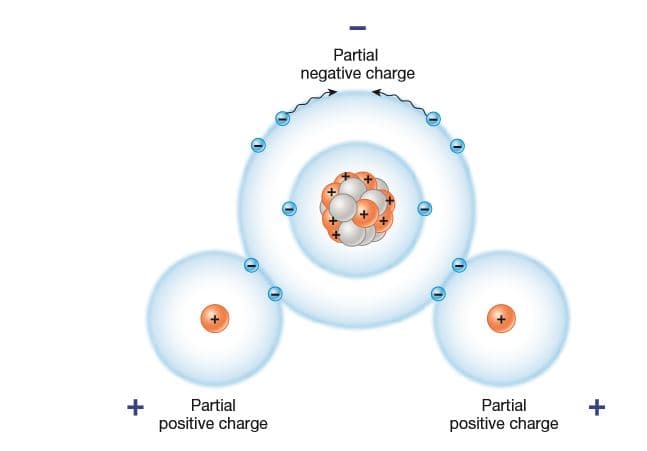Introduction to General, Organic and Biochemistry
11th Edition
ISBN:9781285869759
Author:Frederick A. Bettelheim, William H. Brown, Mary K. Campbell, Shawn O. Farrell, Omar Torres
Publisher:Frederick A. Bettelheim, William H. Brown, Mary K. Campbell, Shawn O. Farrell, Omar Torres
Chapter3: Chemical Bonds
Section: Chapter Questions
Problem 3.23P: 3-23 Predict which ions are stable: (a) (b) (c) (d) (e) (f)
Related questions
Question
Q1: Where are the covalent bonds in this figure?
Q2: This figure shows a water molecule (H2O). A hydrogen molecule (H2) consists of two hydrogen nuclei that share two electrons. Draw a simple diagram of a hydrogen molecule indicating the positions of the two electrons.
Q3: When table salt (sodium chloride, NaCl) dissolves in water, it separates into a sodium ion (Na+) and a chloride ion (Cl–). Which portion of a water molecule would attract the sodium ion, and which portion would attract the chloride ion?

Transcribed Image Text:Partial
negative charge
+
Partial
Partial
positive charge
positive charge
+
Expert Solution
This question has been solved!
Explore an expertly crafted, step-by-step solution for a thorough understanding of key concepts.
Step by step
Solved in 4 steps with 3 images

Knowledge Booster
Learn more about
Need a deep-dive on the concept behind this application? Look no further. Learn more about this topic, chemistry and related others by exploring similar questions and additional content below.Recommended textbooks for you

Introduction to General, Organic and Biochemistry
Chemistry
ISBN:
9781285869759
Author:
Frederick A. Bettelheim, William H. Brown, Mary K. Campbell, Shawn O. Farrell, Omar Torres
Publisher:
Cengage Learning

Introduction to General, Organic and Biochemistry
Chemistry
ISBN:
9781285869759
Author:
Frederick A. Bettelheim, William H. Brown, Mary K. Campbell, Shawn O. Farrell, Omar Torres
Publisher:
Cengage Learning